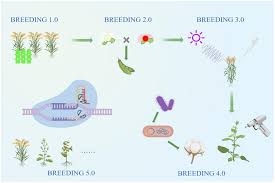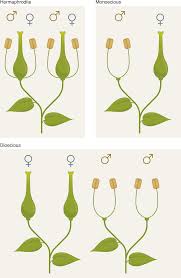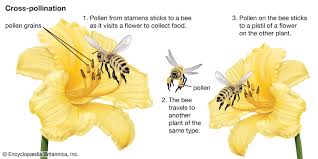During pollination, when pollen grains of a flower are conveyed by wind, insects, or other agents to the stigma of another flower, the crop is said to be cross-pollinated.
Cross-pollinated plants exhibit great variations in floral organization and modes of reproduction. In this article, the different methods used in breeding cross-pollinated crops will be examined.
Read Also: How to Grow, Use and Care for Whiteedge Flatsedge Grass (Cyperus flavicomus)
Methods of Breeding Cross-Pollinated Crops in Agriculture

Cross-pollinated plants exhibit great variations in floral organization and modes of reproduction. As a result, diverse methods are employed for their breeding. The methods commonly used include introduction, selection, development of synthetic varieties, and hybridization.
This method is similar to that used with self-pollinated plants. It involves introducing a source of desirable genes into the population. Suitable crosses are made with the new variety to introduce these genes.
1. Selection Method in Cross-Pollinated Crop Breeding
Mass selection is more commonly used in cross-pollinated plants, unlike self-pollinated plants. This is because cross-pollinated plants are highly heterozygous, and individual plants are unable to maintain their purity due to segregation and cross-pollination.
In mass selection, a large number of individual plants with improved phenotypic characteristics are selected and bulked together.
Their seeds are harvested and grown the following year. However, plants such as castor, sunflower, cotton, and jute give better results with progeny selection rather than mass selection, as they are often harvested and evaluated as individual plants.
If genes for a particular quantitative character are to be concentrated, recurrent selection is used. In the first step, plants with improved yield are selected, and their progeny is obtained after setting and grown in separate rows.
Plants from different rows are then crossed in all possible combinations to produce hybrids. Seeds are composited, and a population is established for the first recurrent selection cycle. The entire process is repeated until improvement is shown in the character under investigation.
2. Development of Synthetic Varieties in Cross-Pollinated Crops
This method entails the development of a new variety of plants by combining seeds of individual plants or strains into a synthetic variety. The success of this method, however, depends on the combining ability of the component strains.
New varieties of crops such as maize and sugar beets have been developed using this method. It has been observed that synthetic varieties of maize are not as effective as hybrid seeds but are superior to open-pollinated varieties.
Read Also: How To Grow, Use and Care For Threeawn Grass (Aristida Spp.)
Hybridization in Cross-Pollinated Crop Breeding

Hybridization involves inter-varietal or interspecific crosses of crops with desirable genotypes or characteristics. Many crops are normally heterozygous, and this heterozygosity is maintained from one generation to the next through cross-pollination. Cross-pollination often leads to the development of hybrid vigor.
Hybrid plants with improved characteristics are self-pollinated for a few generations to achieve homozygosity for a desirable character. Afterward, the hybrid population is subjected to progeny selection, and desirable lines are selected and multiplied.
For example, in the production of hybrid maize seeds, homozygous inbred lines are first established. Then, these inbred lines are crossed in suitable combinations to yield better crops.
Simple cross hybrids are then crossed together to produce better double-cross hybrids. It should be noted, however, that where hybrid vigor is lost, it can be restored by out-crossing.
Diverse methods are employed for the breeding of cross-pollinated crops. The methods popularly used include introduction, selection, and hybridization. For pollination to be successful, pollen must be transferred between plants of the same species.
For example, a rose flower must always receive rose pollen, and a pine tree must always receive pine pollen. Plants typically rely on one of two methods of pollination: cross-pollination or self-pollination, though some species are capable of both.
Most plants are designed for cross-pollination, in which pollen is transferred between different plants of the same species. Cross-pollination ensures that beneficial genes are transmitted relatively quickly to succeeding generations.
If a beneficial gene occurs in just one plant, that plant’s pollen or eggs can produce seeds that develop into numerous offspring carrying the beneficial gene. The offspring, through cross-pollination, transmit the gene to even more plants in the next generation.
Cross-pollination introduces genetic diversity into the population at a rate that enables the species to cope with a changing environment.
New genes ensure that at least some individuals can endure new diseases, climate changes, or new predators, enabling the species as a whole to survive and reproduce.
Plant species that use cross-pollination have special features that enhance this method. For instance, some plants have pollen grains that are lightweight and dry, making them easily swept up by the wind and carried long distances to other plants. Other plants have pollen and eggs that mature at different times, preventing the possibility of self-pollination.
In self-pollination, pollen is transferred from the stamens to the pistil within one flower. The resulting seeds and the plants they produce inherit the genetic information of only one parent, and the new plants are genetically identical to the parent.
The advantage of self-pollination is the assurance of seed production when no pollinators, such as bees or birds, are present. It also allows for rapid propagation weed plants typically self-pollinate and can produce an entire population from a single plant.
The primary disadvantage of self-pollination is the genetic uniformity of the population, making it vulnerable to extinction by a single devastating disease to which all genetically identical plants are equally susceptible.
Another disadvantage is that beneficial genes do not spread as rapidly as in cross-pollination because one plant with a beneficial gene can transmit it only to its own offspring and not to other plants. Self-pollination evolved later than cross-pollination and may have developed as a survival mechanism in harsh environments where pollinators were scarce.
Most plants have specialized reproductive structures cones or flowers where the gametes, or sex cells, are produced. Cones are the reproductive structures of spruce, pine, fir, cycads, and certain other gymnosperms and are of two types: male and female. On conifers such as fir, spruce, and pine trees, the male cones are produced in the spring.
The cones form in clusters of 10 to 50 on the tips of the lower branches. Each cone typically measures 1 to 4 cm (0.4 to 1.5 in) and consists of numerous soft, green, spirally attached scales shaped like a bud.
Thousands of pollen grains are produced on the lower surface of each scale and are released to the wind when they mature in late spring.
The male cones dry out and shrivel up after their pollen is shed. The female cones typically develop on the upper branches of the same tree that produces the male cones.
They form as individual cones or in groups of two or three. A female cone is two to five times longer than the male cone, and starts out with green, spirally attached scales. The scales open the first spring to take in the drifting pollen. After pollination, the scales close for one to two years to protect the developing seed.
During this time, the scales gradually become brown and stiff the cones typically associated with conifers. When the seeds are mature, the scales of certain species separate, and the mature seeds are dispersed by the wind. In other species, small animals such as gray jays, chipmunks, or squirrels break the scales apart before swallowing some of the enclosed seeds.
They cache, or hide, other seeds in various locations, which results in effective seed dispersal and eventually germination since the animals do not always return for the stored seeds.
Pollination occurs in cone-bearing plants when the wind blows pollen from the male to the female cone. Some pollen grains are trapped by the pollen drop, a sticky substance produced by the ovule, the egg-containing structure that becomes the seed.
As the pollen drop dries, it draws a pollen grain through a tiny hole into the ovule, and the events leading to fertilization begin.
The pollen grain germinates and produces a short tube, a pollen tube, which grows through the tissues of the ovule and contacts the egg. A sperm cell moves through the tube to the egg where it unites with it in fertilization. The fertilized egg develops into an embryonic plant, and at the same time, tissues in the ovule undergo complex changes.
The inner tissues become food for the embryo, and the outer wall of the ovule hardens into a seed coat. The ovule thus becomes a seed a tough structure containing an embryonic plant and its food supply. The seed remains tucked in the closed cone scale until it matures, and the cone scales open. Each scale of a cone bears two seeds on its upper surface.
Do you have any questions, suggestions, or contributions? If so, please feel free to use the comment box below to share your thoughts. We also encourage you to kindly share this information with others who might benefit from it. Since we can’t reach everyone at once, we truly appreciate your help in spreading the word. Thank you so much for your support and for sharing!

